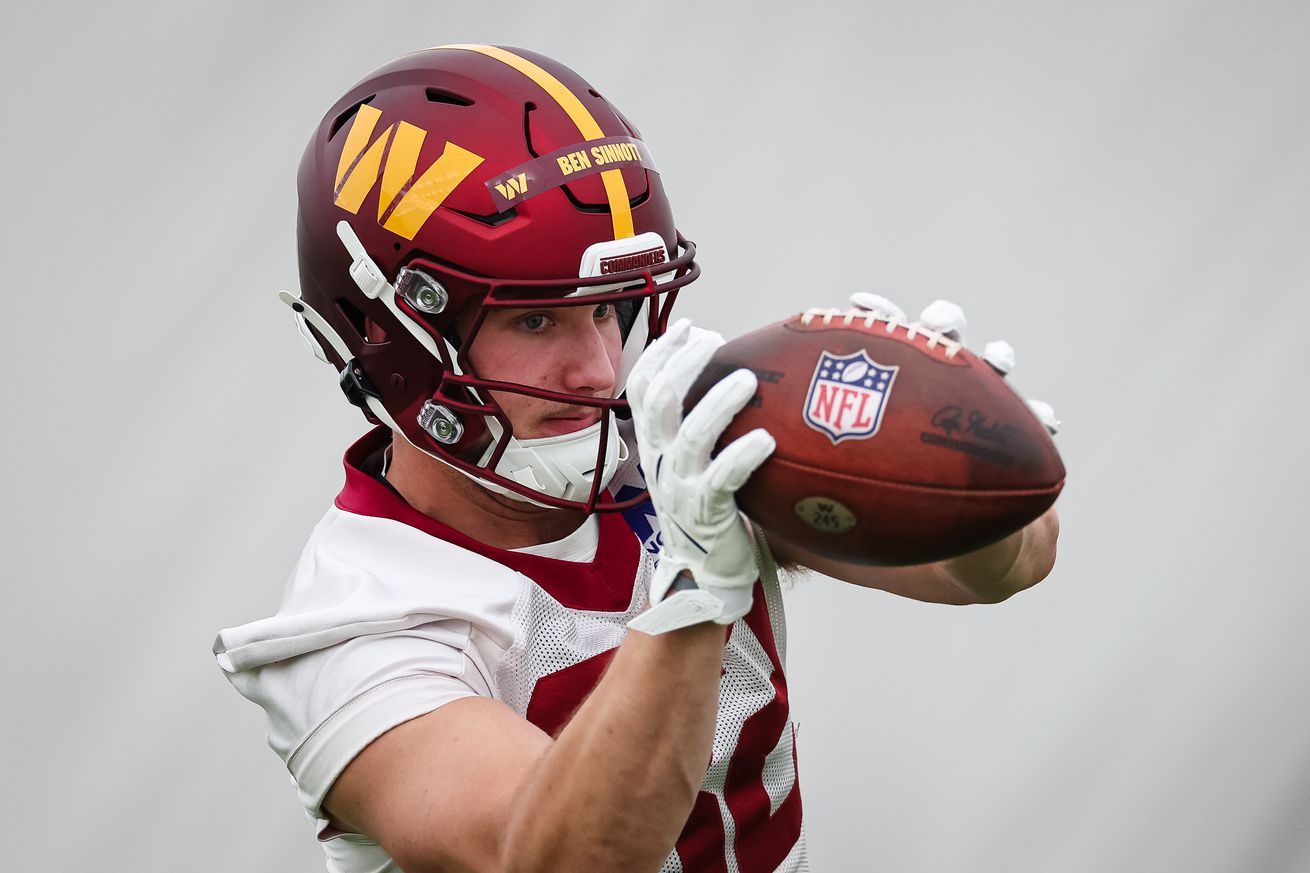
Reconnecting with a key piece of the Redskin legacy
While others have been fixated on the new QB, or obsessing about the offensive line, the member of the Commanders’ 2024 draft class I am most excited about is second-round pick Ben Sinnott. It’s not that I am not overjoyed that Adam Peters corrected 24+ years of draft buffoonery by selecting QB Jayden Daniels with the second overall pick in the draft. I am actually making a concerted effort to avoid getting overly invested in our rookie QB.
My excitement about the Sinnott pick was initially sparked by what we learned about it in the immediate aftermath of the draft. As I reported in the first episode of my series, “What We Learned about Adam Peters in the 2024 Draft”, the Commanders had Sinnott rated highly enough to keep them from taking trade offers from the Jets’ Joe Douglas as the 53rd pick neared. The reason for that became apparent when Adam Peters’ spoke to the media at the end of Day 2:
I’m not comparing him to the guys we had in San Francisco, but he reminds me of guys like Kyle Juszczyk and George Kittle. The way he blocks and in the way he moves, and just the way he competes. Certainly not putting him in that, those guys are All Pro’s, Pro Bowlers, everything you’d want, but Ben has that same mindset and he plays with that mindset. He can block really anywhere. You can put him at the end of the line of scrimmage and you can block a D end, you can block a linebacker, you can block a defensive back in space, you’ll block two people on the same play. If you saw that highlight, that was pretty cool. He can play fullback and block people on the second level, so he can do anything you want in the run game and in the pass game. He’s got great hands, can get open. He can beat man coverage, and he’s got that mindset when he gets the ball in his hands, he is not going down. So, he’s got everything we’re looking for in a Commander as well.
What am I so excited about?
Those who have read my articles on Hogs Haven will know that I have a particular enthusiasm for the fullback position, which is deeply rooted in my experience as a Redskins’ fan over more than 50 years. The Diesel engine who powered the Redskins’ offense through the dawn of the Joe Gibbs glory years was a fullback. Needless to say, Peters’ comparison – that wasn’t a comparison – to the 49ers’ first team All-Pro fullback Kyle Juszczyk got my attention.
Ben Sinnott is obviously a very different player to John Riggins. At Kansas State, Sinnott played predominantly as an F tight end, not a running back. What the two have in common, aside from playing college football in The Sunflower State, are certain commonalities of their utilization on the field, and more importantly, playing with a certain mindset that Peters referred to.
The fullback is the most poorly understood position in today’s NFL. Prevailing opinion among fans of teams that don’t currently roster a fullback seems to be that it is merely a vestige of a bygone era when football was played in leather helmets on frozen mud fields. There is some truth to that, but not much.
Commanders’ fans might be surprised to learn that 15 NFL teams currently roster a fullback, including six of eight teams that played in the 2023 divisional playoff round. The Kansas City Chiefs broke with Andy Reid’s long-standing commitment to the position last season. They appear to have corrected that lapse through the addition of UDFA running back Carson Steele this offseason.
I have encountered a wide range of views and misconceptions about the fullback position. Fullbacks are often characterized as oversized, lumbering running backs, who take occasional snaps in short yardage situations. While there are elements of truth to that perception, it is based on a misconception of the position’s past, and bears relatively little relation to how the fullback is used today.
The fullback position can be defined in a variety of ways. The use the term “fullback”, can be based on a position label on a depth chart, an alignment in the backfield, a set of responsibilities on offense, or even a player’s size. Each of these definitions can have some truth to them, but can also be too restrictive and even, in some cases, misleading. While nearly half of NFL teams dedicate a roster position a fullback, others incorporate the fullback role into the responsibilities of tight ends, as the Kansas State Wildcats did with Sinnott.
What really unifies fullbacks past and present is something that transcends mere Xs and Os or RAS scores. It is an attitude, that mindset that Adam Peters referred to. In the words of the greatest fullback – and arguably player – of all time, Jim Brown:
Make sure when anyone tackles you he remembers how much it hurts
Ben Sinnott may be listed as a TE on the Commanders’ depth chart, but this is how a fullback finishes a reception:
All aboard! @ben_sinnott pic.twitter.com/RGBeR0C597
— K-State Football (@KStateFB) August 10, 2024
If that doesn’t get you excited for the coming NFL season, you might be a fan of the wrong sport. Or maybe you just don’t have a soul.
As pleased as I was by the prospects of seeing Ben Sinnott taking the occasional snap at fullback this season, my enthusiasm was further piqued by something that happened at final roster cutdowns. Rather than giving the last roster spot to preseason standout DE K.J. Henry or CB Tariq Castro-Fields, to bolster positions of need, Peters awarded it to the lesser known Colson Yankoff, who had mainly drawn attention throughout the preseason due to his curious surname.
Yankoff seemed like an intriguing longshot to make the roster when he was signed as a UDFA after the draft. The former four-star QB recruit out of Idaho took a circuitous route through the University of Washington to establish a role as special teams’ star and occasionally used halfback in Chip Kelly’s offense at UCLA. What could the Commanders have seen in Yankoff to make them prioritise a roster spot for a TE prospect with practically no experience at the position?
While I was entertaining that question, the Commanders announced the signing of former Seahawks LB/FB and special teams ace, Nick Bellore to the practice squad. At that point, it couldn’t be just a coincidence.
A little digging revealed a few converging lines of evidence pointing to a new wrinkle we can expect to see added to the Commanders’ offense this season. But before getting into that, let’s take a look at the modern fullback role and how it relates to the tight end position.
Fullbacks and Fullback-like Tight Ends in Today’s NFL
A Brief History of the Fullback
Reflecting its Rugby origins, the positions in the American football backfield were originally named for how far back players lined up from the front row. The fullback lined up the furthest away from the line of scrimmage, and therefore played fully back. The halfback lined up half way between the fullback and the line. The term quarterback was coined in the 1940’s to distinguish a newly emerging back who played closest to the line.
The fullback position has undergone considerable changes since the 1960’s, as summarized in my article History and Evolution of the Fullback. The fullback was the featured running back in most NFL offenses until the mid-1960s, when it took a backseat to the halfback. Throughout the Super Bowl era, the running game as a whole lost ground to the passing offense, and fullback utilization diminished.
Along the way, the fullback began to be placed ahead of the half back, in position to block. Today, despite the name being retained, the fullback aligns upfield of the half back, who is usually just called a running back.
The last featured fullback in an NFL offense was the Buccaneers’ Mike Alstott. When Alstott hung up his cleats in 2006, 42 fullbacks recorded stats for 30 NFL teams. The next decade witnessed a mass extinction event. By 2016, only four fullbacks recorded yards from scrimmage.
There is a common misconception that that was the end of the fullback position. In fact, since reaching the low point in 2016, fullback numbers have rebounded. However, the fullbacks that emerged from that evolutionary bottleneck are different from their predecessors.
Fullbacks in Today’s NFL
In addition to the change in backfield alignment, there have been two fundamental changes the fullback position since their glory era ended in the 1960s. Today’s fullbacks are role players rather than featured backs, and they have more in common with tight ends than running backs.
The following table shows utilization of the 15 fullbacks who got touches on offense in 2023.
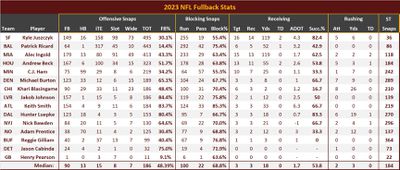
There are a few key takeaways:
Teams that use fullbacks the most tend to be good. While 15 teams roster a fullback, only five teams use them on more than 20% of offensive snaps. Four of the five heavy users made the playoffs in 2023, including two that reached the conference round. The fact that Super Bowl was not a matchup of fullbacks was an anomaly, since Chiefs’ head coach Andy Reid normally uses one in his offense.
Fullbacks move around the offense. The column entitled FB% refers to the percentage of a player’s snaps that he spent actually lined up as a fullback. The teams that utilize fullbacks the most, tend to move them around the formation. Many fullbacks spend time lined up at inline tight end (iTE) and running back (HB), with occasional snaps in the slot and out wide. A few teams like the Raiders, Falcons and Cowboys have specialist fullbacks who play over 80% of snaps aligned at the position.
There is one massive exception, literally and figuratively. Judging by utilization, the Raven’s 2023 second-team All-Pro FB, Patrick Ricard, is actually a 300 lb inline tight end. Although he does take more snaps as a fullback than the average tight end.
Fullbacks are predominantly run blockers. The Block% column refers to the percentage of a players’ offensive snaps spent blocking. Fullbacks are selfless heroes on offense, spending an average of around 69% of their time protecting or making way for others. The average ratio of run blocking to pass blocking snaps is nearly to 5:1. Minnesota’s C.J. Ham is the only fullback approaching an equal split of pass to run blocking and, technically, he is really more of a halfback than a fullback.
Fullbacks are secret weapons in the passing game. Traditionally, fullbacks were grouped with running backs. In today’s NFL, fullbacks get more touches as receivers than running backs. Fullbacks can provide a valuable outlet for QBs in need a of a checkdown, or a sneaky mismatch target underneath when releasing from blocking in play action. They are often used as receivers in short yardage and goal line situations.
While they aren’t targeted often, when they are, they tend to be highly effective. Five fullbacks achieved Success Rates (Succ.%) over 65% in 2023. For comparison, only one of 16 wide receivers with comparable ADOT (-1.0 to 6.3) achieved a Success Rate over 65% (Ray-Ray McCloud, 49ers, 66.7%). The most successful receiving fullback, Kyle Juszczyk (49ers) achieved an amazing Success Rate of 82.4%, catching 14 of 16 passes for 119 yds, 2 TDs and 8 first downs.
Today’s fullbacks are only occasionally used as running backs, nearly always in short yardage and goal line situations. One who deserves special mention in this regard is the Cowboy’s Hunter Luepke, a player I felt the Commanders should have kept from falling into the wrong hands. In his rookie season, after signing as an UDFA with Dallas, Luepke only rushed 6 times for 19 yards, which does not seem that impressive. However, his 6 rushing attempts produced 5 first downs and 1 TD, which is.
Fullbacks are demons on special teams. Every fullback who registered offensive snaps also played on special teams in 2023, including All-Pros Kyle Juszczyk and Patrick Ricard, and most were heavy contributors. You don’t see many All-Pro wide receivers or running backs playing on teams. Three more fullbacks only saw action on special teams: Alex Armah (Commanders, 142 snaps), Darrell Daniels (Lions, 70 snaps), Ben Mason (Ravens, 19 snaps).
Eleven fullbacks played more than 100 special teams snaps and seven played over 200. Fullbacks participated in all phases on special teams and were most active on kick returns and punt coverage, averaging 62.5 snaps and 52.5 snaps on the respective special teams units. Eleven of 18 fullbacks registered tackles in special teams coverage. Four fullbacks led their peers with four tackles apiece: Keith Smith, Jakob Johnson, Jason Cabinda, Hunter Luepke. Cabinda, a converted linebacker, was the most productive with 4 tackles on only 38 coverage snaps (10.5%).
Fullback-like Tight Ends
With tight competition for roster space, not all teams who would like them can afford to devote a roster spot to a full time fullback. Depending on how you define it, somewhere between 9 and 14 other teams have incorporated the fullback role into the responsibilities of one of their tight ends. The Packers, who have one of the greatest traditions at fullback, have doubled up with a dedicated fullback and tight end Josiah Deguara, who actually took more snaps lined up at FB. Interestingly, it was rare for teams to line up running backs as fullbacks in 2023.
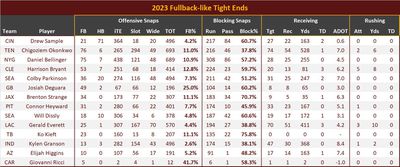
The fullback-like tight ends are sorted by the number of offensive snaps lined up in the backfield (FB + HB). They were a mixture of inline (Y) and F-tight ends. Like their fullback cousins, tight ends who took at least 10% of their offensive snaps in the backfield tended to act predominantly as run blockers and receivers, although there was more variation in the proportion of time spent blocking than among the fullbacks. Only three out of 14 had more than one rushing attempt, and the maximum was five.
Commanders’ Coaching History with Fullbacks
One reason that I am convinced we will see more utilization of the fullback role this season is that the coaching staff and front office is loaded with devotees to the position. I have mentioned Adam Peters’ comments on the reasons for selecting Ben Sinnott in the draft, and the comparison to his former team’s All-Pro fullback, Kyle Juszczyk. Assistant GM Lance Newmark hails from the Detroit Lions, another fullback friendly team. With the exception of passing game coordinator, Brian Johnson, the other senior offensive coaches and head coach Dan Quinn all have strong histories of using fullbacks in their offenses.
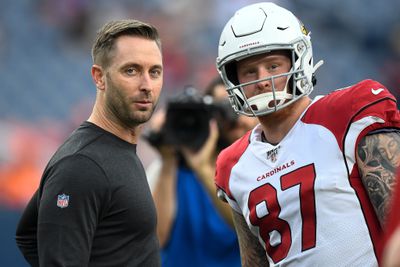
Photo by Dustin Bradford/Getty Images
Offensive Coordinator Kliff Kingsbury
There are a lot of misconceptions about Kliff Kingsbury’s offense in Arizona due to his association with college Air Raid schemes. Despite what you may have heard, he ran a fairly balanced offense with the Cardinals, with a strong running game. Commanders’ fans may be surprised to learn that he used designated fullbacks on offense throughout his first three pro seasons, and made frequent use of tight ends lined up as fullbacks in all four seasons.
Kingsbury utilized fullback Darrell Daniels as a run blocker in the backfield and split out as an inline TE throughout his first three seasons in Arizona. Daniels was joined by backup FB Jonathan Ward in 2021. Kingsbury’s fullbacks were used occasionally as receivers, at about normal levels for the modern game. Kingsbury never used fullbacks to run the ball, preferring instead to use running backs in short yardage situations.
Kingsbury made additional use of tight ends Charles Clay (2019), Maxx Williams (2019-2022), Dan Arnold (2020), Demetrius Harris (2021) and Trey McBride (2022) lined up as fullbacks in the backfield.
Altogether, Kingsbury lined up players as fullbacks in the backfield on an average of 107 offensive snaps per season throughout his time in Arizona. That constitutes above average fullback utilization by today’s standards.
Forget what you might have thought about Kingsbury, his pro offense was fullback friendly.
Run Game Coordinator/RB Coach Anthony Lynn
Anthony Lynn is a former head coach and offensive coordinator, so we can expect him to have some input on how the offense is run. If Kingsbury is a friend of the fullback, Lynn is more of an enthusiast. I mentioned earlier that the number of teams playing fullbacks dropped to four in 2016. One of the teams that kept the faith was Buffalo, with Lynn as offensive coordinator and running backs coach.
Lynn has made heavy use of fullbacks, by contemporary standards, throughout his time as head coach and senior offensive coach with the Chargers, Bills, Lions and 49ers. Lynn’s offenses have featured some of greatest fullbacks of the modern era, including Jerome Felton, Derek Watt, Gabe Nabers, Jason Cabinda and Kyle Juszczyk. His fullbacks have exceeded 280 snaps in four of the past 9 seasons, which puts him near the extreme end of fullback utilization in the modern game.
Lynn has used his fullbacks to run the football as well as providing occasional receiving targets, which marks one difference from Kingsbury. Over the past 9 years, Lynn’s fullbacks have average 7.9 receiving targets and 4.8 rushing attempts per year.
Head Coach Dan Quinn
One of the other teams to stick with the fullback through their near extinction in 2016 was Dan Quinn’s Atlanta Falcons, with Kyle Shanahan as offensive coordinator. Quinn’s offense in Atlanta was one of the few to use a fullback even more than Lynn’s offenses. While you might think that is more of a reflection of Kyle Shanahan being the greatest fullback proponent in the modern game, Quinn’s use of the position continued after Shanahan’s departure to San Francisco in 2017.
In half of Quinn’s 6 seasons in Atlanta, fullbacks Patrick DiMarco and Keith Smith played more than 300 snaps. During Quinn’s tenure as head coach, fullbacks averaged 8.5 targets and 2 rushing attempts per season.
Passing Game Coordinator Brian Johnson
Johnson is the odd man out among the Commanders’ offensive coaches. During his sole season as offensive coordinator with the Eagles in 2023, he did not have a fullback at his disposal. Although an argument could be made that QB Jalen Hurts has some fullback in his game (h: 6’1”, w: 223, Avg. 327 run blocking snaps p.a. since 2021). The lack of experience with fullbacks might not be Johnson’s fault. The Eagles have been one of the few teams that does not use a fullback or a TE lined up as a fullback in their offense since Andy Reid took the fullbacks with him to Kansas City in 2013.
In summary, aside from Johnson, the Commanders have assembled a front office and coaching staff of fullback enthusiasts.
Who’s going to play fullback for Washington?
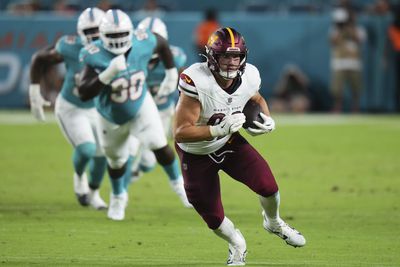
Photo by Rich Storry/Getty Images
TE Ben Sinnott
Measurements: 6’4”, 250 lbs, 4.68 sec 40, RAS 9.73
Draft: 2024 draft pick, round 2, 53rd overall out of Kansas State
2023 Stats: 73 Tgt, 43 Rec (58.9% Rec), 669 yds, 6 TDs, 31 first downs, ADOT 10.1 yds
Sinnott was used as an F tight end and increased his receiving production through three seasons with the Wildcats. His 58.9% catch rate is not particularly low for a receiver with an ADOT above 10 yds. Anything he gave away by not making more catches, he more than made up for with an impressive 6.8 Yards After Catch/Reception, which ranked 7th among NCAA tight ends (min. 52 targets). His overall receiving productivity of 2.02 Yards/Route Run was the fourth highest among college tight ends.
Kansas State aligned Sinnott in the backfield on 12.8% of his offensive snaps in his final season and at fullback on 10.6% of snaps. He played the majority of his snaps lined up as an Those figures are spot-on for a fullback-like tight end.
Sinnott was used as a blocker on 58.1% of offensive snaps, primarily on running plays (836 snaps) and sparingly in pass protection (74 snaps). He had three rushing attempts for 12 yards and a TD in 2021, and did not take another handoff for the remainder of his time in college.
There are conflicting reports about Sinnott’s blocking in college. PFF rated him as the 4th best run blocking TE in college football in 2023 (grade 76.1, min 291 blocking snaps) and tied for 8th best pass blocker (grade 72.8). Lance Zeirlein, on the other hand, felt that he “failed to fit up run blocks with much command or force” and that he “will not offer much help as a single blocker in pass pro”. Based on Adam Peters’ comments, the Commanders scouts clearly agreed with PFF more than Zeirlein.
I expect to see the Commanders to play Sinnott in a fairly conventional F tight end role this season, lining up mainly inline, with some snaps in the slot, and occasionally in the backfield as a fullback in short yardage and goal line situations. I wouldn’t be surprised to see him used on a few screens and routes out of the backfield. It will be interesting to see if he gets any carries, given the different approaches of Kingsbury and the other coaches.
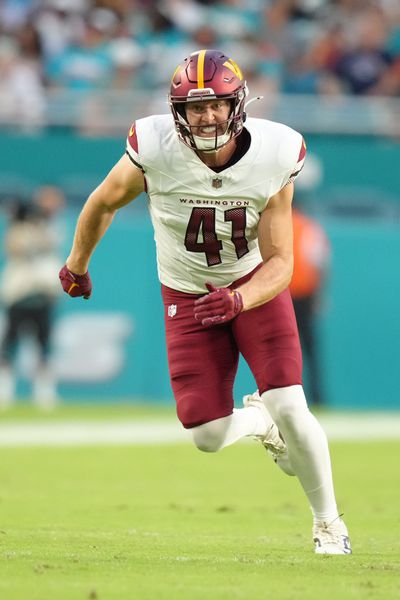
Photo by Peter Joneleit/Icon Sportswire via Getty Images
TE Colson Yankoff
Measurements: 6’3”, 233 lbs, 4.61 sec 40, RAS 9.56
Draft: 2024 UDFA out of UCLA
2023 Stats
Receiving: 1 Tgt, 1 Rec, -2 yds; Rushing: 13 Att, 83 yds, 1 TD
Special Teams: 216 snaps (115 coverage), 10 tackles, 2 missed tackles, 0 penalties
Yankoff is a bit of a mystery, having struggled to find a position on offense throughout his college career. He was primarily used on special teams return and coverage units at UCLA, where he was highly effective at hunting down and tackling returners.
He played 117 snaps on offense as a running back in his final two seasons. In his final season he lined up as a fullback on around 20% of his offensive snaps. He saw limited action as a receiver on screen passes, peaking with 7 receptions on 8 targets for 51 yds and 2 TDs in 2022.
He switched positions to tight end for the NFL draft to capitalize on his length and plus athleticism. The Commanders gave Yankoff an extended audition in preseason on special teams. He played the most special team snaps (50) by a comfortable margin, and led the team with 2 tackles and 1 assist.
On offense, Yankoff played 41 preseason snaps at inline tight end, 29 in the slot and 9 (11.3%) lined up as a fullback. He caught 3/3 targets for 23 yds. He was used as a blocker on 40% of offensive snaps, with all but one as a run blocker.
I would expect to see Yankoff playing primarily on special teams in his rookie season. If he does get playing time on offense, I would expect to see him used in a fairly similar role to Sinnott. However, it wouldn’t surprise me to see him get a few carries, given his background as a running back and the flashes he showed in the preseason.
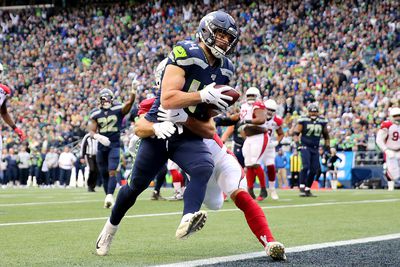
Photo by Abbie Parr/Getty Images
LB/FB Nick Bellore
Measurements: 6’1”, 250 lbs, 4.91 sec 40, RAS 4.44, Short Shuttle 4.0 sec, 3-Cone 6.98 sec
Draft: 2011 UDFA out of Central Michigan
2023 Stats
Defense: 8 tackles, 6 assists
Special Teams: 364 snaps (145 coverage), 6 tackles, 3 assists, 3 missed tackles, 1 penalty
Bellore was a late addition to the Commanders’ practice squad, where he is reunited with Commanders’ special teams coach Larry Izzo, who he worked with in Seattle since 2019.
Bellore has primarily been a special teams star throughout his 13 year career with the Jets, 49ers, Lions and Seahawks. He was voted to the Pro Bowl special teams roster last season at age 34, and also in 2020.
He played a single season as a starting linebacker with the 49ers in 2016. Since then, he has seen limited action on defense and has been used occasionally, each season as a fullback on offense.
If Bellore is elevated to the 53 man roster this season, my best guess is that it would be to fill a sudden shortage on special teams. Although, if Sinnott and Yankoff both go down, the Commanders could find themselves suddenly short of fullbacks. So it will be good to have him around.
TL:DR
If you couldn’t read all of that, what you really need to know is:
The fullback is the least understood position on NFL rosters.
Today’s fullbacks primarily serve as run blockers in the backfield, but also line up as inline tight ends and occasional receiving targets. Modern fullbacks may also get occasional rushing touches in short yardage situations, but some teams don’t use them to run the football at all.
Nearly half of NFL teams rostered a fullback in 2023. Dedicated fullbacks are always significant contributors on special teams. Another 9 to 13 teams use tight ends to fulfill the fullback role as part of their responsibilities.
The Commanders’ front office and coaching staff is loaded with fullback enthusiasts.
As part of Adam Peter’s roster makeover, the team has added three players who are ideally suited to fill the fullback role in Kliff Kingsbury’s offense.
Commanders’ fans can look forward to seeing Ben Sinnott punish defenders on lead blocks and after the catch on receptions from alignments inline, in the slot and out of the backfield. If we are really lucky, we may even get to see him run occasionally on short yardage downs.
The fullback position is of such obvious importance to the Commanders’ new regime that they have allocated precious roster space to Colson Yankoff, who can fill in for Sinnott if he goes down, and signed the ageless wonder Nick Bellore to the practice squad, just in case.
I doubt we will see Kliff Kingsbury run Sinnott on nine 50-guts in a row, but I am hopeful that we will see a more rugged brand of football on offense this season, featuring burly men coming out of the backfield to make defenders remember how much it hurts to attempt to tackle Commanders.
